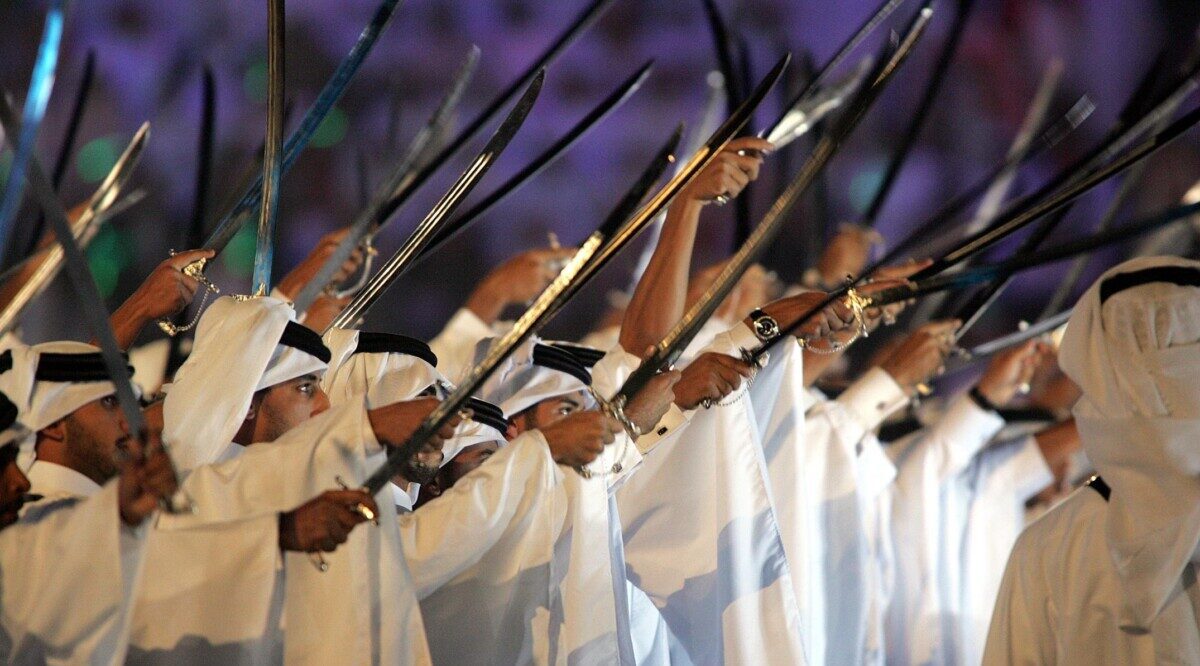With both a Bedouin as well as a maritime heritage, Qatar's music and dance are characterised by the elements of Bedouin life, sailing and pearling. This article will explore those features.

Introduction
Qatar’s culture is based on Bedouin poetry, song and dance. However, because of the few archives available on the importance of its culture, its original development and raison d’être have not been documented properly. The music and its different presentations and performances no longer exist in their original contexts in the Gulf region, but have been performed in a variety of situations in order to bridge that gap. The two main themes in the region, the sea and the Bedouins, are reinforced in the rhythms of the music.
Qatar’s traditional dances
The ardha and razeef and the fishermen’s dances are Qatar’s traditional dances. The ardha is originally a war dance but is said to have become a dance of peace in recent history. It represents the majority of folkloric dancing performed at national events, festivities and weddings in Qatar. The ardha is the name given to the two lines of men chanting to or at each other in a competitive or challenging fashion; the razeef being the dancing element that accompanies or follows it.
As the Bedouins moved around the Qatari peninsula, taking advantage of seasonal benefits, the seas around it were the scenery of those trading, fishing and pearling. These elements were part of an art special to the people of the Gulf, especially among the Arab tribes that migrated from the Najd region.
The elements of the sea, like elsewhere in the world, were associated with the loading and unloading of cargoes, illustrated by one type of song or chant. At sea, sailors sang chants coupled with the raising of sails by hauling lines in unison, lifting a heavy anchor or rowing for long periods of time.
In addition, spending long periods at sea and the impact it had on the sailors and their families, was also a subject of maritime songs. As a result, the chants they sang contained the elements of love, patience and fate.
The Ardha
The importance of the ardha is far more profound than just a dance. The events at which it is performed are social occasions whose origins lie in the tribal societies that made their home in the Peninsula and the Arabian hinterland. The meetings have a number of functions; political, strategic, social and entertaining. When tribes gather to show allegiance, they perform the razeef as an important and highly visible element of the event.
The ardha may be held first and foremost in order to demonstrate association and loyalty in a traditional, political setting. It might also serve as a formal or informal gathering where family issues are discussed, including marriages.
Essentially a war dance, dancers in the ardha can be seen wearing bandoliers and carrying guns of different ages or swords in a typical display of martial strength and loyalty to the ruler, as a show of respect to both himself and the country. Two lines of men, facing one another, chant in response to a single person leading them in an eight-bar refrain. In between, men present their weapons in a slow moving, individualist display. The call and response from the lines of men can be powerful, but also humouristic or insulting to their enemies.
The drums are the most important element of the ardha as there is no tune to carry. The rhythm is important to the pace of the dancers who use the whole of their bodies to move in time with the beat. In the fishing and pearling traditions of Gulf music, percussion is a strong element. Clapping, producing a hard, dry sound, is part of the ardha and razeef.
While it is the men of the tribe who dance and sing, there are dances where women participate, though in a less open-air setting. The na’ashat and radha are the most common. The former is characterised by the women sweeping their hair rhythmically to the beat of the music and is common to badu traditions. The latter is a processional performance associated with weddings.
The Modern Face of Traditional Music
The music of Qatar is affiliated with Arabic songs, and was influenced during the last thirty years by the Gulf arts. Most Qataris enjoy listening to Khaliji (Gulf) music in the style of the traditional Bedouin music, accompanied by an array of percussion instruments, including al-ras (a large drum whose leather is heated by an open fire), tambourine and cymbals, along with small drums.
Other instruments played in Qatar include the ud and rebaba, both string instruments, as well as the Arabian flute. This music dominates the airwaves in the capital Doha, yet the younger generations play and enjoy music from Egypt, and Lebanon as well as from other areas of the Arab world, Europe and North America.
Qatar knows many associations encouraging music in the country. The Qatari Gulf Folklore Center teaches Qatari folk music. In 2005, Doha Community Orchestra has established a whole symphony orchestra; they play concerts and rehearse at The American School of Doha. Doha Jazz has also taken part in the music scene of Qatar; the Doha Jazz festival ranks high offering world-class music. The Qatar Music Academy is developed by Qatar Foundation centres, offering music education throughout the country and creating an environment of lively inspiration.

